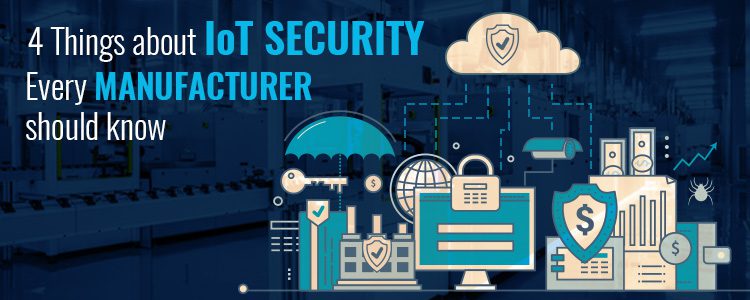4 Things About IoT Security Every Manufacturer Should Know

IoT Security, a must for all Enterprises adopting IIoT Solutions
Highlights
- IoT Security is a major reason for putting majority and laggards on backfoot in adopting IIoT for Industry 4.0 solutions
- Every Manufacturer needs to know some pointers about IoT security before proceeding
- IoT is an amalgamation of existing technologies like sensors, cloud, data analytics etc. Access & Data Security for these elements can be handled separately
- The Enterprise needs to move to a security-oriented culture, from the top floor to shop floor
- Ensure that your IoT vendor is well versed & serious about IoT security as you
- Like E-commerce, digital wallets IoT will mature with time, making the consumers landscape more confident
With Industry 4.0 revolution, manufacturing world is going through a rapid change in ideas for innovation, Internet of Things being one of them. The innovators and early adopters from manufacturing sector are aggressively looking to adopt IIoT to gain overall equipment effectiveness, condition based monitoring, remote asset monitoring, and predictive analysis, hoping to gain a sustainable competitive advantage. However, while doing so, there is always a concern about overall security. Cases like Nissan leaf or Cherokee put majority and laggards on backfoot in adopting new technology solutions. Gartner in its report has put security on top 10 lists of enablers for IoT adoption. Having said that, here are four key aspects that every manufacturer should know about IoT security.
Here are a few things every manufacturer should know about IoT security before embarking on an Industry 4.0 journey:
- IoT is not completely new/unknown: IoT is not a completely isolated novel technology. Quite the opposite it is a combination/assembly of existing technologies like sensors, cloud, data analytics etc. Securing each element of the network as it deals with access & data related developments at each point. At Altizon, we study the proposed architecture for implementation and divide it into major parts: Sensors & Machines, Gateway & IoT Platform & the output rendered through custom solution apps. The incoming and outgoing data from each of these are encrypted & strictly monitored and is accessible only to authentic & authorized users. The best practices in the industry around authentication, encryption & connectivity are followed, along with some proprietary measures to ensure optimum security. Physical security on premise is also critical since that is where the data is generated and where the sensors & machines reside.
- Move towards a security-oriented culture: The most important measure of all, the implementing enterprise itself needs to move to a security-oriented culture. Since, the IoT system is connected to Enterprise systems like ERP, CRM for greater insights, security needs to be robust everywhere. In many cases, a minor mistake by an internal stakeholder is responsible for the enterprise network to be exposed to malicious elements. To prevent this, action needs to be taken at two levels:: the top floor & the shop floor. The board (top floor) needs to acknowledge the importance of security in its entirety including IoT security measures & organize awareness training sessions for both the management as well as the team. Adequate budgets need to be sanctioned & interactions with industry innovators need to be carried out periodically to adopt best practices. The IT department should ensure the basic hygiene steps like keeping the softwares updated, closing unused networking ports, encrypting & access controlling the critical data etc.
- Is your IoT Provider Security Ready too: IoT, is not just another technology that is a good to have, it is fast turning out to be the first step in a journey of an enterprise towards digital transformation & smart manufacturing processes. Hence, your IoT implementation partner is not just your one project vendor, but a long-term partner for an effective collaborative approach towards manufacturing. A typical enterprise usually has multiple vendors with overlapping dependencies on the same project, resulting in making it project complicated, less agile. Hence, before embarking on an IoT journey, it is always wise to check via a security audit if your partner is adequately geared up to take care of the security aspect of the project too. This will also enable you to incorporate security in the design phase of IoT implementation, making the foundation of the project robust & security aligned.
- With time comes maturity: Remember the time when e-commerce, digital banking, and wallets were all futuristic ideas? The implementation and adoption of these in our day to day life seemed far-fetched then. But with time, the technology landscape and the customer approach both gain enough maturity to sort out the kinks. Industry standards, legal guidelines are all developed by then to protect both the customer and end user. Industrial IoT is no different.
At Altizon, we believe security to be one of the most critical enablers of IoT. With an approach of one size never fits all, each IoT implementation should be looked at separately. By performing IoT and security assessment at primary stage itself, one can design a deployment architecture that secures each network element at the design stage itself. IoT can then fearlessly proceed to make a digital transformation for the enterprise a reality and usher in an era of Industry 4.0.
To know more about IIoT security and best practices for IoT adoption, schedule a free consultation call with Altizon IIoT expert.




